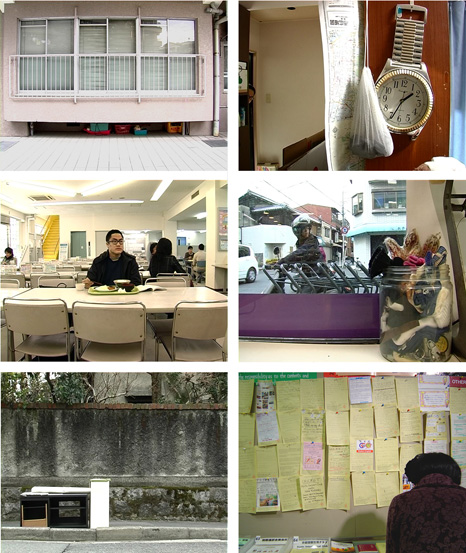
ã“ã®ãƒ—ãƒã‚¸ã‚§ã‚¯ãƒˆã¯ã€ã€Œpassing通用ã™ã‚‹ã“ã¨ã€âˆ’周囲ã®äººã«æ°—ã¥ã‹ã‚Œãªã„よã†ã«ç‰¹å®šã®å ´æ‰€ã«å…¥ã‚Šè¾¼ã‚‚ã†ã¨ã™ã‚‹ã“ã¨ã€å¤±æ•—ã™ã‚‹ã¨è§£ã£ã¦ã„㪠ãŒã‚‰ã‚‚京都 ã®æ—¥å¸¸ç”Ÿæ´»ã«å¿ã³è¾¼ã‚‚ã†ã¨ã™ã‚‹ã“ã¨â€ã®å•ã„ã‹ã‘ã¨ã—ã¦é–‹å§‹ã•ã‚Œã¾ã—ãŸã€‚ã—ã‹ã—ã€ã€Œè¨€èªžã€ã€ãã—ã¦ã€Œå‡ºè‡ªã€ã«å¯¾ã™ã‚‹å•ã„ã‹ã‘ã¯ã€ã‚ˆã‚Šã„ã£ãã†ã‚¢ã‚¤ãƒ‡ãƒ³ãƒ†ã‚£ ティæ„è˜ã‚’高ã‚ã‚‹ã“ã¨ã«ãªã‚Šã€ãã—ã¦ã€Œpassingã€ã¯ã€Œpassing back and forthã‚„ã‚Šã¨ã‚Šã‚’ã™ã‚‹ã“ã¨ã€ã¨ã„ã£ãŸæ„味ã§ã‚ˆã‚Šç§ã®é–¢å¿ƒã‚’ã²ãよã†ã«ãªã‚Šã¾ã—ãŸã€‚言語やæ„味ã®äº¤æ›ã¯ã€ç§ã«ã¨ã£ã¦äººã‚„ã‚‚ã®ã€å ´æ‰€ã®é–“ã®è·é›¢ã‚’ãŸã©ã‚‹ ãŸã‚ã®æ‰‹æ®µã¨ãªã£ãŸã®ã§ã™ã€‚ã©ã“ã¸è¡Œã“ã†ã¨ã‚‚−アーãƒãƒ³ãƒ»ãƒ—ランナーã€æ—…行者ã€ã‚ã‚‹ã„ã¯åœ°å…ƒä½æ°‘ã€ã©ã®ã‚ˆã†ãªè€…ã¨ã—ã¦ã§ã‚れ−ã€ç§ãŸã¡ã¯è‡ª 身をå–ã‚Šå·»ã環境ã¨é–¢ä¿‚ã‚’å–ã‚Šçµã¼ã†ã¨ã™ã‚‹ 生æ¥ã®ã€ãã—ã¦æœ¬èƒ½çš„ãªãƒžãƒƒãƒ”ング・プãƒã‚»ã‚¹ã‚’æŒã£ã¦ã„ã¾ã™ã€‚ã—ã‹ã—ã€åœ°å›³ãŒç§ãŸã¡ã«ã‚‚ãŸã‚‰ã™æœ€å¤§ã®éŒ¯è¦šã¨ã¯ã€åœŸåœ°ã¯æ•´ç„¶ã¨ã—ãŸå›³é¢ã‚„æ ¼åã§è¡¨ç¾ã•ã‚Œã€å· ã¯å›³å¼åŒ–ã•ã‚ŒãŸå½¢ã¨ã—ã¦è¡¨ç¾ã•ã‚Œã¦ã„ã‚‹ã«ã‚‚é–¢ã‚らãšã€ãã“ã«ä¿¡é ¼æ€§ã‚„具体的ãªå®¢è¦³æ€§ãŒã‚ã‚‹ã¨æ€ã‚ã›ã¦ã—ã¾ã†ã“ã¨ã§ã™ã€‚実際ã€éƒ½å¸‚ã®è¡¨è±¡ã¨ã—ã¦ã®åœ°å›³ã¯ã€ç©º é–“ã«å›ºå®šã•ã‚ŒãŸåœ°ç‚¹ã®è»Œè·¡ã§ã‚ã‚‹ãŒæ•…ã«ã€Œç‰©èªžã€ã®å¤šæ§˜æ€§ã‚’示ã—ã¦ã„ã‚‹ã¨ã‚‚ã„ãˆã‚‹ã®ã§ã™ã€‚ã—ãŸãŒã£ã¦ã€äº¬éƒ½ã‚’å¦ã¶ã“ã¨ã¯ã€å®Ÿéš›ã®å¤‰æ•°ã‚’知るã¨ã„ã†ã‚ˆã‚Šã€åŒæ™‚ ã«èµ·ã“る「活動ã®çµæžœã€ã«ã¤ã„ã¦çŸ¥ã‚‹ã“ã¨ã«ãªã‚‹ã®ã§ã™ã€‚åŒã˜æ„味ã«ãŠã„ã¦ã€ã‚¢ã‚¤ãƒ‡ãƒ³ãƒ†ã‚£ãƒ†ã‚£ã¯è¡Œç‚ºã«åŸºç¤Žã‚’ç½®ã„ã¦ã„ã¾ã™ã€‚ミシェル・ド・セ ルトーã¯ã€Œä½•ã‹ã‚’ã—よã†ã¨ã™ã‚‹æ„å¿—(un vouloir-faire)ã€ã«ã‚ˆã£ã¦äººé–“を評価ã—ã¾ã™ã€‚ãã—ã¦ãã®æ„å¿—ã¯ç§ãŸã¡ãŒã€æ™®æ®µç¹Šç´°ãªãƒ¡ã‚¿ãƒ»ã‚³ãƒŸãƒ¥ãƒ‹ã‚±ãƒ¼ã‚·ãƒ§ãƒ³ã®ä¸ã§ãƒãƒ©ãƒ³ã‚¹ã‚’ã¨ã£ã¦ã„ã‚‹ç¾ å®Ÿã¨é¡˜æœ›ã€ã‚ã‚Šã®ã¾ã¾ã®ã‚‚ã®ã¨åŠ å·¥ã•ã‚ŒãŸã‚‚ã®ã€ä¼ãˆã‚‰ã‚ŒãŸã‚‚ã®ã¨å—ã‘å–られãŸã‚‚ã®ã®é–“ã«ã‚るギャップã«ã‚ã‚‹ã¨ç§ã¯è€ƒãˆã¾ã™ã€‚ãã“ã§ã¯ã€ã‹ã¤ã¦ç¢ºå®Ÿæ€§ã‚’æŒã£ ã¦ã¨ã‚‰ãˆã‚‰ã‚Œã¦ã„ãŸæ™‚é–“ã¨å ´æ‰€ã¯ã‚‚ã¯ã‚„確実性を失ã†ã®ã§ã™ã€‚â€ãã—ã¦ã€ç§ãŸã¡ã¯æ—¥ã€…円をæã„ã¦ã„ã‚‹ã®ã§ã™ã€‚This project began as a question of ‘passing’, of trying to insert oneself into the situation invisibly, of slipping into the daily life of Kyoto in a premeditated failure of assimilation. But very quickly, language and the question of nativity led to a much more relational sense of identification, and ‘passing’ became much more interesting in the sense of ‘passing back and forth’. Language and the exchange of meaning became the tools with which to trace the distances between person, object and place.Wherever we go, whether as tourist, native resident or urban planner, there is an inherent and instinctive mapping process with which we engage our surroundings. But the greatest illusion of the map, however, is its misleading sense of authority, of concrete objectivity in the face of a neatly laid out plan, a grid or a logically designed river. In fact, the map, as an image of the city, is a multiplicity of narratives inasmuch as it is a trajectory of points fixed in space. To learn about Kyoto becomes less about a real mapped variable than a simultaneous ‘result of activities’.In the same sense, identity becomes based upon production. de Certeau measures being by “un vouloir-faire”, or will to do, and it is within these gaps between reality and aspiration, natural and fabricated or transmitted and received that we find the rhythms of a delicate meta-communication. The former rooted-ness of time and place are no longer valid. We walk in circles everyday.
Deprecated: Function link_pages is deprecated since version 2.1.0! Use wp_link_pages() instead. in /hermes/walnacweb06/walnacweb06al/b1319/moo.ourwork/iwish/wp-includes/functions.php on line 6121
Deprecated: Function comments_rss_link is deprecated since version 2.5.0! Use post_comments_feed_link() instead. in /hermes/walnacweb06/walnacweb06al/b1319/moo.ourwork/iwish/wp-includes/functions.php on line 6121
RSS 2.0 feed. You can leave a response, or trackback from your own site.
